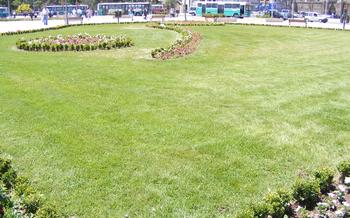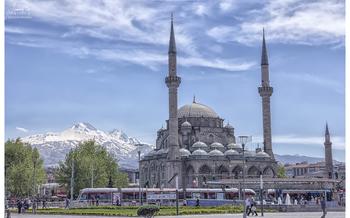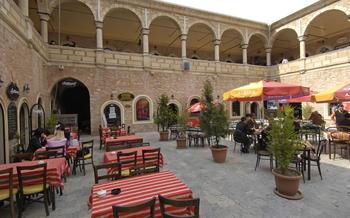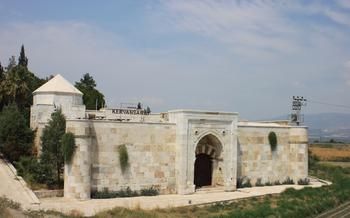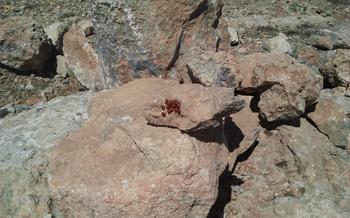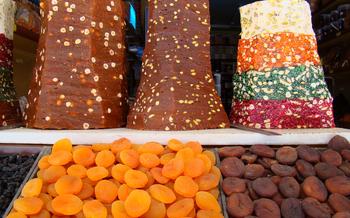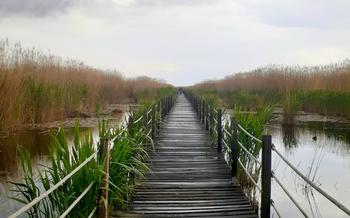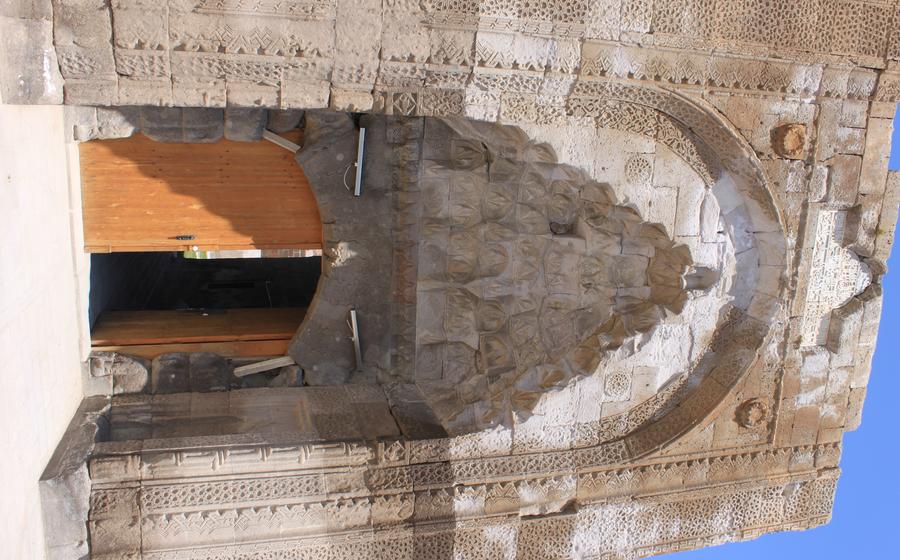
Karatay Han
- Historical Significance
- Location and Accessibility
- Opening Hours and Admission Fees
- Exploring the Caravanserai's Courtyard
- The Grand Entrance and Portal
- The Caravanserai's Market Stalls
- The Mosque and Prayer Hall
- Dining Options at Karatay Han
- Shopping for Souvenirs and Handicrafts
- Photography Opportunities
- Nearby Attractions and Points of Interest
- Historical Significance of the Caravanserai
- Karatay Han in Popular Culture
- Insider Tip: Hidden Gems to Discover
Historical Significance
The Karatay Han is a testament to the rich history and architectural prowess of the Seljuk Turks. Built in the 13th century by the Seljuk vizier Celaleddin Karatay, the caravanserai served as a vital hub along the Silk Road, facilitating trade and cultural exchange between the East and the West. Its strategic location at the crossroads of major trade routes made it a bustling center of commerce, where merchants from far-off lands gathered to buy and sell goods, exchange ideas, and forge alliances. The caravanserai's grandeur and intricate architecture reflect the Seljuk's power and influence during this period, making it a significant landmark in Turkish history.
Location and Accessibility
The Karatay Han is conveniently situated in the heart of Kayseri, at Kayseri Caddesi No:111, Kocasinan/Kayseri. Reaching the caravanserai is a breeze, thanks to its excellent accessibility by various modes of transport.
For those relying on public transport, hop on any bus that stops near the Kayseri Bus Terminal and disembark at the Hunat Hatun Cami stop. From there, it's just a short walk to the Karatay Han.
If you prefer the flexibility of driving, follow the signs to the city center and keep an eye out for the Karatay Han sign. Ample parking spaces are available in the vicinity, ensuring a hassle-free visit.
Opening Hours and Admission Fees
Current opening hours: At present, Karatay Han welcomes visitors every day of the week, except for Mondays when it remains closed. Throughout the week, including weekends, the caravanserai's doors remain open from 9:00 a.m. to 6:00 p.m., granting ample time for exploration and appreciation of its remarkable history and architecture.
Regular admission prices: Admission to Karatay Han is affordably set at a standard rate of 20 Turkish Lira for all visitors, ensuring its accessibility to travelers and locals alike. This fee contributes to the preservation and maintenance of this invaluable cultural heritage site.
Discounts and concessions: Children under the age of 12 are admitted free of cost, providing an opportunity for families to experience the wonders of the caravanserai together. Additionally, students and visitors over the age of 65 are eligible for discounted admission, upon presentation of a valid ID.
Guided tour options: Guided tours are available for those who seek a more comprehensive and in-depth exploration of Karatay Han. Professional guides, well-versed in the caravanserai's history and architecture, lead these tours, providing insightful commentary and anecdotes that bring the site to life. Guided tours typically last for 30 to 45 minutes and can be arranged in multiple languages, including English, German, and French.
Exploring the Caravanserai's Courtyard
The central courtyard of Karatay Han is a testament to the architectural brilliance of the Seljuk era. Designed to facilitate the movement of goods and people, the courtyard's layout is both functional and aesthetically pleasing. Surrounded by two-story arched galleries, the courtyard creates a sense of spaciousness and grandeur.
The architectural details of the courtyard are intricate and captivating. The pointed arches, supported by sturdy columns, add a rhythmic pattern to the space. The walls are adorned with decorative carvings and inscriptions, showcasing the artistic prowess of the Seljuk artisans. The courtyard is also home to a beautiful fountain, which once provided water for the travelers and their animals.
One of the highlights of the courtyard is its decorative elements. The walls are adorned with intricate tilework, featuring geometric patterns and floral motifs. The vibrant colors of the tiles create a striking contrast against the warm tones of the stone. The courtyard is also home to several niches and alcoves, which were used for storage or as resting places for travelers.
The courtyard of Karatay Han is a photographer's paradise. The play of light and shadow on the architectural details creates a variety of stunning compositions. Visitors can capture the grandeur of the courtyard from different angles, highlighting the intricate carvings, the rhythmic arches, and the beautiful fountain.
The Grand Entrance and Portal
The grand entrance of Karatay Han is a captivating sight, showcasing the architectural prowess of the Seljuk era. Its imposing arched portal, constructed using finely cut stone, exudes an aura of majesty and grandeur. The intricate carvings that adorn the entrance depict various motifs, including geometric patterns, stylized plants, and calligraphic inscriptions, adding to the overall aesthetic appeal.
The portal's design is not merely ornamental; it also holds historical significance. The inscriptions provide valuable insights into the caravanserai's construction and its role in the region's trade and commerce. Furthermore, the entrance served as a ceremonial gateway, welcoming dignitaries and merchants who traveled along the Silk Road.
Beyond the portal lies the caravanserai's central courtyard, which reveals an array of architectural wonders and bustling activity. The entrance itself becomes a frame through which visitors can glimpse the vibrant life within the caravanserai, creating a sense of anticipation and excitement as they step inside.
The Caravanserai's Market Stalls
The bustling market stalls at Karatay Han are a vibrant hub of activity and a must-visit for those seeking authentic Turkish handicrafts and souvenirs. From intricately woven carpets and hand-painted ceramics to traditional Turkish delights and aromatic spices, the stalls offer a diverse array of goods that reflect the country's rich cultural heritage.
Strolling through the labyrinthine alleys of the caravanserai, you'll encounter friendly vendors eager to showcase their wares and share stories about their craftsmanship. Whether you're looking for a unique piece of jewelry, a colorful scarf, or a hand-carved wooden artifact, the market stalls are a treasure trove of unique finds.
One of the highlights of the market is the opportunity to witness artisans at work, creating exquisite pieces right before your eyes. From skilled weavers using ancient techniques to potters molding intricate designs, the market is a living testament to Turkey's thriving artisanal traditions.
Remember to embrace the local custom of bargaining when making purchases. While the vendors are generally fair in their pricing, a bit of friendly negotiation can often lead to a great deal. Be respectful and engage in the bargaining process with a smile, and you'll likely walk away with some amazing finds at a fraction of the original price.
The Mosque and Prayer Hall
Located within the caravanserai's courtyard, the mosque holds a significant religious and architectural presence. Its construction during the Seljuk era showcases the blending of Islamic and Anatolian design elements. The prayer hall, adorned with intricate tilework and calligraphy, exudes a serene and spiritual ambiance. Visitors can marvel at the beautifully preserved mihrab, a niche indicating the direction of Mecca, and the minaret, which rises gracefully above the caravanserai's skyline. The mosque has stood as a beacon of faith for centuries, serving as a place of worship and contemplation for weary travelers and locals alike.
Dining Options at Karatay Han
Delight Your Palate with Traditional Turkish Cuisine
Indulge in a culinary journey through Turkish gastronomy at the restaurants and cafes nestled within the Karatay Han complex. Savor the flavors of authentic Turkish dishes, expertly prepared using fresh, local ingredients. Experience the warmth of Turkish hospitality as you dine in the serene courtyard, surrounded by the architectural grandeur of the caravanserai.
For a taste of traditional Turkish fare, try the mouthwatering "pide," a savory flatbread topped with minced meat, vegetables, or cheese. Don't miss the chance to sample "manti," delicate dumplings filled with minced meat and yogurt sauce.
Vegetarians will find a haven in the array of meze, an assortment of small plates featuring grilled vegetables, stuffed grape leaves, and creamy hummus. Pair your meal with a refreshing glass of ayran, a traditional yogurt drink, or indulge in the rich flavor of Turkish coffee, a perfect conclusion to your dining experience.
Must-Try Recommendations:
- Testi Kebabı: Slow-cooked lamb or beef in a sealed clay pot, a specialty of the Kayseri region.
- Kayseri Mantısı: Delicate dumplings served with garlic yogurt sauce and topped with crispy fried garlic and paprika.
- Katmer: A flaky pastry filled with cheese, meat, or vegetables, a local favorite.
- Sıkma: A traditional Turkish dessert similar to a funnel cake, drizzled with honey or molasses.
Shopping for Souvenirs and Handicrafts
The bustling market stalls within Karatay Han's courtyard present an enticing array of souvenirs and handicrafts, offering visitors a chance to take home a piece of Turkey's rich cultural heritage. Local artisans showcase their skills, displaying an assortment of traditional Turkish crafts, from intricate carpets and textiles to hand-painted ceramics and decorative glassware.
When shopping for souvenirs, be sure to keep an eye out for unique items that reflect the region's cultural identity. Kayseri is renowned for its distinctive carpets, woven with vibrant colors and intricate patterns that tell stories of nomadic traditions. The delicate craftsmanship of these carpets makes them a cherished souvenir.
Haggling is an essential part of the shopping experience in Turkey, and visitors are encouraged to engage in friendly bargaining with the stall owners. With a bit of patience and a smile, you can often secure a fair price for your desired souvenirs while supporting local artisans.
Among the must-have items to consider are hand-painted ceramics, adorned with intricate designs inspired by Turkish motifs. These ceramics range from decorative plates and bowls to ornate vases and tiles, adding a touch of vibrant color to any home.
Kayseri's rich culinary heritage is also reflected in its selection of souvenirs. Local sweets, such as Turkish delight and baklava, are popular choices for visitors who wish to savor the flavors of the region. These sweet treats are often beautifully packaged, making them ideal gifts for friends and family back home.
Photography Opportunities
The Karatay Han offers a treasure trove of photography opportunities for capturing its architectural splendor and the vibrant cultural atmosphere within its walls. Here are some tips to help you make the most of your photographic experience:
- Best Spots for Capturing the Caravanserai's Beauty:
Central Courtyard: The central courtyard provides a panoramic view of the caravanserai's architectural features. Capture the symmetry, intricate carvings, and the play of light and shadow.
Grand Entrance: The monumental entrance with its impressive portal is a must-shoot spot. Get low to capture the full grandeur and the decorative details above.
Market Stalls: The vibrant market stalls add color and life to your photos. Capture the merchants displaying their wares, the colorful textiles, and the bustling atmosphere.
- Tips for Capturing the Architectural Details:
Focus on Details: Zoom in to capture the intricate carvings, inscriptions, and decorative elements that adorn the caravanserai's facades, portals, and columns.
Play with Light and Shadow: The changing light conditions throughout the day create dramatic effects. Visit during the golden hours of sunrise or sunset to capture the warm glow illuminating the caravanserai's stonework.
Experiment with Different Angles: Don't just shoot from eye level. Try low angles to emphasize the height of the structures, or high angles to capture the expanse of the courtyard.
- Lighting Conditions and Timing:
Early Morning and Late Afternoon: The soft, warm light of these times is ideal for capturing the caravanserai's beauty without harsh shadows.
Overcast Days: Cloudy skies provide even, diffused light, which is excellent for capturing the details of the architecture.
- Instagram-worthy Shots:
People in Action: Include people interacting with the caravanserai's elements, such as merchants at their stalls or visitors exploring the courtyard.
Unique Perspectives: Look for unusual angles or vantage points that offer a fresh perspective on the caravanserai.
Utilize Leading Lines: The arches, columns, and walkways of the caravanserai create natural leading lines that draw the viewer's eye into the image.
Nearby Attractions and Points of Interest
Kayseri Castle
Just a short walk from Karatay Han, Kayseri Castle stands as a testament to the city's rich and storied past. Built in the 6th century AD, the castle has witnessed countless battles and sieges throughout the ages. Today, it's open to the public as a museum, where visitors can explore its ramparts, towers, and dungeons, and learn about its fascinating history.
Hunat Hatun Mosque
Another nearby attraction is the Hunat Hatun Mosque, a beautiful example of Seljuk architecture. Built in the 13th century AD, the mosque is known for its intricate stone carvings and its stunning blue-tiled dome. Visitors are welcome to enter the mosque and admire its interior, which is as impressive as its exterior.
Sahabiye Medresesi
For those interested in Islamic architecture, the Sahabiye Medresesi is a must-visit. Built in the 13th century AD, this former theological school is now a museum that houses a collection of Islamic artifacts and manuscripts. Visitors can learn about the history of Islam in Turkey and admire the beautiful architecture of the medrese.
The Archaeological Museum
The Kayseri Archaeological Museum is home to a vast collection of artifacts from the region, dating back to prehistoric times. Visitors can see exhibits on the Hittites, the Romans, and the Byzantines, as well as a collection of Islamic art. The museum is a great place to learn about the rich history and culture of Kayseri and the surrounding region.
Historical Significance of the Caravanserai
Karatay Han holds immense historical significance as a vital hub for trade and commerce along the legendary Silk Road. During the Seljuk Empire's reign, the caravanserai played a pivotal role in facilitating the exchange of goods and ideas between the East and the West. Merchants from distant lands, such as China, India, and Persia, converged at Karatay Han to conduct business and trade their exotic wares.
The caravanserai's strategic location at the crossroads of major trade routes made it a thriving center of commerce. Goods from the East, such as spices, silks, and precious stones, were exchanged for European goods, including textiles, glassware, and metalwork. This vibrant exchange of goods and ideas contributed to the region's economic prosperity and cultural diversity.
Karatay Han's architectural design reflects the Seljuk Empire's architectural prowess and serves as a testament to their engineering skills. The caravanserai's massive courtyard, intricate carvings, and imposing entrance gate showcase the Seljuk's mastery of construction and their commitment to aesthetics.
Beyond its commercial significance, Karatay Han also served as a symbol of Seljuk power and authority. Its grand scale and opulent decorations conveyed the empire's wealth and strength, reinforcing its dominance in the region. The presence of a mosque within the caravanserai further emphasized the Seljuk's commitment to their Islamic faith.
Today, Karatay Han stands as a reminder of the Seljuk Empire's legacy and its contributions to trade, architecture, and cultural exchange. Its historical significance continues to attract visitors from around the world who come to marvel at its beauty and learn about its fascinating past.
Karatay Han in Popular Culture
Karatay Han's captivating allure has extended beyond the realm of history and architecture, finding its way into the world of popular culture. The caravanserai's distinctive appearance and rich heritage have made it a sought-after location for filmmakers, writers, and artists seeking to capture the essence of Turkey's past.
In the realm of cinema, Karatay Han has served as a backdrop for several notable films and television shows. Its imposing presence graced the screen in the Turkish historical drama "Diriliş: Ertuğrul," which depicted the life and struggles of the legendary Turkish warrior Ertuğrul Gazi. The caravanserai's intricate architecture and atmospheric setting also lent themselves perfectly to the historical epic "The Magnificent Century," which chronicled the reign of the Ottoman Sultan Suleiman the Magnificent.
Beyond the world of film, Karatay Han has also captured the imagination of writers and poets. In the realm of literature, the caravanserai has been immortalized in the works of renowned Turkish authors such as Ahmet Hamdi Tanpınar and Orhan Pamuk. Tanpınar's novel "Huzur" ("Peace") features a poignant scene set within the caravanserai's walls, while Pamuk's acclaimed "The Museum of Innocence" makes subtle references to the historical significance of the site.
The caravanserai's allure extends beyond the written word, inspiring artists from various disciplines to create works that pay homage to its beauty and grandeur. Painters, photographers, and illustrators have captured the essence of Karatay Han on canvas, film, and paper, preserving its image for generations to come.
These cultural representations of Karatay Han serve as a testament to its enduring legacy and the profound impact it has had on Turkish society. The caravanserai's presence in popular culture ensures that its story will continue to be told and its significance appreciated by generations to come.
Insider Tip: Hidden Gems to Discover
Beyond the main attractions of the Karatay Han, there are hidden gems waiting to be discovered by curious travelers. Explore the caravanserai's lesser-known corners and uncover its secrets.
- Secret Passageways and Hidden Chambers:
-
Rumor has it that the caravanserai contains secret passageways and hidden chambers, once used by travelers and traders for shelter or storage.
-
Rooftop Views:
-
Climb to the rooftop of the caravanserai for a breathtaking panoramic view of Kayseri. Capture stunning photos of the city skyline and the surrounding mountains.
-
Off-the-Beaten-Path Corners for Tranquility:
- Escape the crowds and find solace in the caravanserai's quieter corners. Relax in the shade of the courtyard trees or explore the peaceful gardens.
